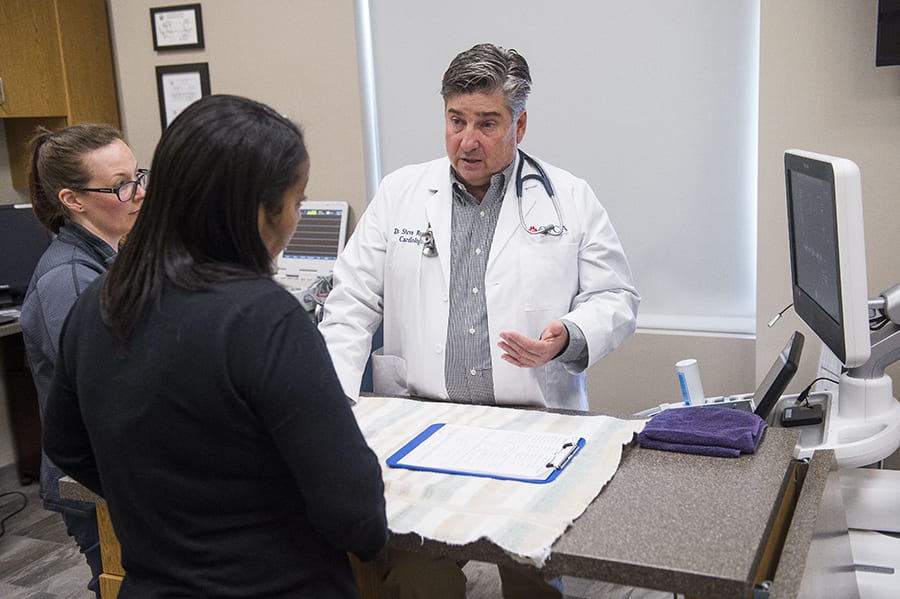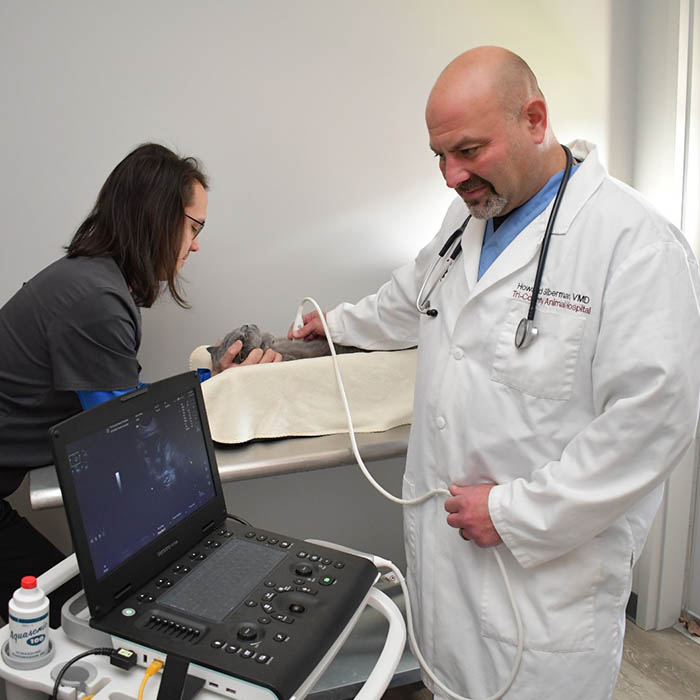The Duty of Ultrasound and CT Check in Modern Veterinary Practices: Insights From Experienced Professionals
In modern-day veterinary methods, ultrasound and CT scans considerably improve diagnostic capabilities. These imaging strategies supply important insights into animal wellness, assisting therapy decisions. Experienced experts acknowledge the distinct benefits of each method. Ultrasound supplies real-time analyses, while CT checks deliver detailed anatomical information. Recognizing their functions and applications elevates important inquiries regarding their influence on individual outcomes and the future of vet diagnostics. What insights can be gotten from their integrated usage?
Recognizing Ultrasound in Vet Medication
Ultrasound is a vital diagnostic device in vet medication, using a non-invasive technique to picture interior structures. This imaging technique uses high-frequency sound waves to develop real-time photos of body organs and cells, permitting veterinarians to analyze conditions without surgical intervention. Common applications include reviewing the heart, liver, kidneys, and reproductive organs, as well as keeping track of pregnancies.The treatment is fairly quick and can be executed in different settings, making it an easily accessible choice for veterinarians. Unlike radiography, ultrasound provides comprehensive information regarding soft tissues and blood circulation, which is important for exact diagnoses.Veterinary specialists depend on ultrasound to identify abnormalities such as tumors, cysts, and liquid accumulation. Its capacity to lead biopsies and various other procedures even more boosts its utility in scientific practice. By using a risk-free and effective method to analyze interior anatomy, ultrasound has become a foundation of modern veterinary diagnostics.
The Benefits of CT Scans for Pet Diagnostics
CT checks deal considerable advantages in veterinary diagnostics by providing improved accuracy in determining internal problems (CT Scans For Animals). As a non-invasive imaging strategy, they ensure the safety and convenience of pets during examinations. In enhancement, CT scans help with a complete evaluation of internal frameworks, permitting much more effective treatment preparation
Boosted Analysis Precision
Developments in imaging technology have actually significantly enhanced diagnostic precision in vet medication, especially with the usage of CT scans. These scans provide in-depth cross-sectional photos of a pet's inner frameworks, permitting vets to determine problems with accuracy. The high resolution and three-dimensional capabilities of CT imaging help with the detection of conditions such as tumors, fractures, and interior bleeding that might be missed with standard imaging approaches. In addition, CT scans can aid in pre-surgical preparation by offering a comprehensive view of anatomical relationships. This degree of information not just enhances the precision of medical diagnoses however also help in tailoring reliable therapy plans. The integration of CT modern technology right into veterinary practices is changing the landscape of pet health care, boosting results for people.
Non-Invasive Imaging Method
The intro of non-invasive imaging methods has changed animal diagnostics, with CT checks becoming a famous device in vet methods. These scans give high-resolution, cross-sectional pictures of an animal's internal structures, permitting veterinarians to evaluate complex problems without the need for intrusive procedures. The advantages of CT scans include their capacity to spot tumors, cracks, and internal blood loss with amazing precision. Furthermore, they help with the assessment of soft tissues and body organs, improving analysis capacities. The speed of CT scanning enables fast decision-making, which is vital in emergency situation circumstances. By minimizing stress and anxiety and discomfort for the animal, CT scans contribute to a much more humane technique to diagnostics, inevitably boosting treatment outcomes and advancing vet care.
Comprehensive Internal Analysis
A detailed internal analysis is important for exact medical diagnosis and reliable therapy in veterinary medication. CT checks offer substantial advantages hereof, giving comprehensive cross-sectional photos of a pet's inner structures. This sophisticated imaging method enhances visualization of complicated physiological areas, making it possible for vets to determine problems such as tumors, fractures, and internal blood loss with better precision. In enhancement, CT scans facilitate the analysis of problems that might be challenging to detect with traditional approaches. The rate and accuracy of CT imaging additionally add to timely interventions, improving client results. As vet techniques progressively integrate CT modern technology, the advantages of considerable internal evaluations end up being obvious, reinforcing the value of this tool in contemporary veterinary diagnostics.
Contrasting Ultrasound and CT Imaging Techniques
While both ultrasound and CT imaging serve vital duties in veterinary diagnostics, each strategy provides unique benefits and constraints that can affect medical decision-making. Ultrasound is particularly valued for its real-time imaging abilities, allowing vets to observe dynamic physiological procedures. This method is non-invasive, portable, and does not entail ionizing radiation, making it a more secure alternative for both animals and clinicians. Ultrasound might have constraints in envisioning certain physiological frameworks or deep tissues.Conversely, CT imaging offers thorough cross-sectional views of the body, permitting for accurate localization of problems. It stands out in assessing complex organs and frameworks, specifically in the thorax and abdomen. Nevertheless, CT scans call for sedation or anesthesia in several situations and entail direct exposure to ionizing radiation. Eventually, the choice in between ultrasound and CT depends on the details scientific scenario, the location of rate of interest, and the seriousness of the analysis requirements.
Instance Studies: Effective Diagnoses Via Imaging
Instance studies show the significant enhancements in diagnostic precision accomplished through sophisticated imaging modern technologies like ultrasound and CT scans in veterinary methods. These developments not just improve the detection of numerous conditions yet likewise help with effective and prompt treatment plans. Evaluating particular cases can highlight the transformative effect of these imaging techniques on vet medication.
Diagnostic Accuracy Improvements

Imaging Innovation Advancements
As veterinary imaging technology remains to progress, its effect on diagnostic capabilities becomes significantly noticeable. Current study highlight the successful application of sophisticated ultrasound and CT check methods in recognizing intricate conditions. A vet facility made use of high-resolution CT scans to diagnose an unusual form of lung cancer in a pet dog, which conventional imaging had missed out on. Similarly, an ultrasound evaluation disclosed a stomach mass in a pet cat, prompting timely medical intervention and a positive outcome. These advancements not only enhance analysis accuracy but also allow veterinarians to develop targeted treatment plans. By leveraging cutting-edge imaging modern technologies, vet experts are considerably boosting client treatment, causing a lot more efficient management of different wellness conditions in animals.
The Function of Imaging in Emergency Veterinary Treatment
Imaging plays a necessary function in emergency situation veterinary treatment, providing vets with important info needed to make fast, educated choices. In urgent scenarios, methods like ultrasound and CT scans make it possible for specialists to promptly analyze an animal's interior frameworks, identifying important conditions such as inner bleeding, fractures, or body organ problems. These imaging modalities enable for real-time analyses, facilitating prompt interventions that can be life-saving. Ultrasound is vital her response for assessing soft tissue injuries and problems like liquid build-up, while CT checks deal detailed images of complex physiological frameworks, essential for diagnosing trauma instances. The rate and accuracy of these imaging methods improve the vet's capability to create reliable therapy strategies, making certain the most effective feasible results for their people. Subsequently, the combination of sophisticated imaging technologies right into emergency veterinary methods is not only beneficial yet increasingly needed, as it boosts analysis abilities and enhances overall animal care during defining moments.
Training and Know-how in Veterinary Imaging
Sophisticated imaging strategies such as ultrasound and CT scans are important for effective vet treatment, the effective implementation of these technologies greatly depends on the training and knowledge of vet experts. Proficient usage of imaging tools requires thorough knowledge of anatomy, pathology, and the principles underlying each technique. Veterinary professionals must go through specific training to accurately analyze imaging outcomes, which is vital for detecting conditions and planning treatment.Certifications and continuing education in vet imaging improve the skills of specialists, allowing them to remain updated with technical improvements. Cooperation between radiologists and veterinarians frequently leads to boosted analysis accuracy, as experts can provide understandings right into complicated cases. Additionally, sensible experience in dealing with imaging tools cultivates confidence in its application. Ultimately, the top quality of vet imaging solutions is straight correlated to the degree of training and knowledge possessed by the specialists making use of these essential diagnostic tools.
Future Trends in Diagnostic Imaging for Animals
With the rapid innovations in modern technology, veterinary analysis imaging is poised for considerable evolution in the coming years. Arising patterns show a change towards more accessible visit their website and mobile imaging methods, such as portable ultrasound tools, which might boost field diagnostics. Furthermore, the integration of artificial intelligence is anticipated to change photo analysis, enabling quicker and extra exact analyses of results.Moreover, innovations in 3D imaging strategies and calculated tomography will certainly offer veterinarians with even more detailed views of animal composition, bring about improved treatment strategies. Virtual reality technology may also contribute in medical planning and education and learning, offering veterinarians an unique point of view on intricate cases.As telemedicine remains to expand, remote assessments facilitated by analysis imaging will certainly become a lot more usual, allowing experts to assist family doctors in real-time. On the whole, these fads are established to improve the efficiency and effectiveness of veterinary care, eventually boosting animal end results.
Often Asked Questions
Exactly How Much Do Ultrasound and CT Checks Price in Vet Centers?
The costs of ultrasound and CT scans in vet centers usually vary from $300 to $1,500, depending upon elements such as place, center type, and specific treatments needed for the animal's diagnosis and therapy.

Are There Any Type Of Risks Related To Ultrasound and CT Checks for Family Pets?
Ultrasound and CT scans normally posture minimal dangers to pets. However, possible issues include sedation reactions and exposure to anesthetics. Cancer Veterinary Near Me. Vets meticulously examine each case to mitigate any kind of threats connected with these diagnostic procedures
How Much Time Do Ultrasound and CT Procedures Usually Take?
Ultrasound treatments normally take about half an hour to an hour, depending on the complexity. CT scans, being more comprehensive, normally need 30 minutes to 90 minutes, including preparation and healing time for the animal.
Can All Veterinarians Perform Ultrasounds and CT Scans?
Not all veterinarians can do ultrasounds and CT scans. Specialized training and qualification are often needed to guarantee expertise in these advanced imaging methods, which might restrict their availability to vets with added credentials and sources.
What Sorts Of Pets Profit The Majority Of From These Imaging Techniques?
Certain animal species, specifically pet dogs and pet cats, advantage considerably from ultrasound and CT scans. These imaging strategies improve analysis precision for problems like lumps, internal injuries, and organ problems, causing enhanced treatment end results and patient care. The high resolution and three-dimensional capacities of CT imaging promote the detection of conditions such as tumors, cracks, and interior bleeding that might be missed out on with typical imaging approaches. Instance researches illustrate the significant improvements in analysis accuracy achieved with sophisticated imaging innovations like ultrasound and CT scans in veterinary practices. Improving diagnostic accuracy in veterinary techniques has actually been significantly assisted by developments in imaging technologies such as ultrasound and CT scans. Advanced imaging techniques such as ultrasound and CT scans are necessary for efficient vet care, the successful application of these technologies greatly depends on the training and expertise of veterinary specialists. Veterinary professionals need to go through specific training to accurately translate imaging results, which is important for diagnosing conditions and planning treatment.Certifications and proceeding education in vet imaging improve the abilities of practitioners, enabling them to remain updated with technological developments.